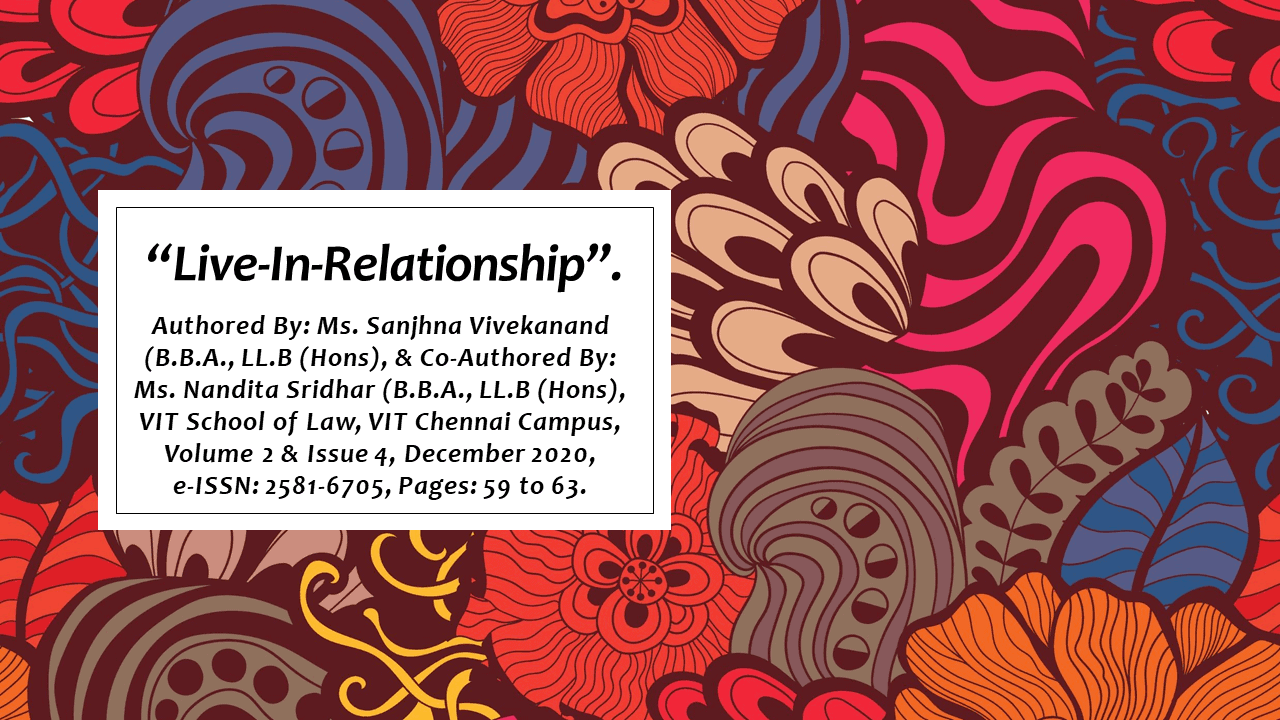Click here to download the full paper (PDF)
Authored By: Ms. Sanjhna Vivekanand (B.B.A., LL.B (Hons), & Co-Authored By: Ms. Nandita Sridhar (B.B.A., LL.B (Hons), VIT School of Law, VIT Chennai Campus.
Click here for Copyright Policy.
Click here for Disclaimer.
I. INTRODUCTION:
Indian society has witnessed a tremendous change in people’s living patterns over the past few years. People are eventually accepting the ideology towards the idea of pre-marital sex and live-in relationships. In comparison to marriage, couples are not married to each other in a live-in relationship, but they live under the same roof which resembles a marriage-like relationship. In legal terms, it is known as cohabitation. In India, where marriage has taken place between the two namely, the man and the woman based on established marriage rules, only certain relationships between a man and a woman are considered legal, otherwise all other kinds of relationships are considered illegitimate. There can be many reasons why people pursue a live-in relationship; but whatever might have been the reason, it is very evident that the institution of marriage is considered to be “sacred” in a traditional society like ours and a good number of couples choose a live-in relationship over marriage, even as a perpetual plan.
In such conditions, many legal and social concerns have become the subject of controversy. Many incidents have been reported and seen over time where partners in live-in relationships or a child born from such a partnership have remained unprotected for the very simple reason that such relationships have been retained beyond the realm of law. In live-in relationships, there has been misused by the partners as they do not have any duties and obligations to fulfill. This essay looks to bring into light a more optimistic approach towards this concept. The authors also aim to show that marriage isn’t the end goal for every relationship. The authors look to prove their stance by highlighting the laws that protect the concept of a live-in relationship.
II. MARRIAGE V. LIVE-IN-RELATIONSHIP:
What most individuals want is the feeling of belonging and being loved, but the bond that marriage binds is too binding for them. And an alternative is a relationship that resembles marriage but without its commitments and obligations. This is when there are live-in relationships in the frame. India being the dynamic and ever-changing country it is, issues such as ‘live-in relationship’ taken up by Western society are increasingly percolating into our social expectations. Another commitment is marriage as well. Every relationship has strengths and demerits of its own. In favour of marriage, the law and culture are biased. Public policy encourages marriage as important for the unity of the family; it is the fundamental unit of society. The law reserves certain rights and privileges for married people in order to protect and promote marriage. Cohabitation does not hold any of those rights or privileges. It can be argued that cohabitation without any of its advantages has all the complications of marriage.
It is known that the Live-in relationship act is without reciprocal statutory obligations for one another. With a complete understanding of the situation, both sides enter into such partnerships. They would also be equated with husband and wife by awarding maintenance or acknowledging rights from such a partnership. Live-in-relationship is purely an agreement between the parties; that relationship comes to an end if a party to a live-in-relationship decides that he/she does not wish to live in such a relationship. It is therefore called a walk-in & walk-out partnership. Live-in-Relationship is neither a crime nor a sin, but in Indian culture, it is to some degree undesirable. The idea of Live-in-Relationship has created a new dimension in the arena of a relationship between men and women in a country like India, where marriages are considered a social justification for legalizing the relationship between a man and a woman.
III. PROVISIONS IN LAW PERTAINING TO LIVE-IN RELATIONSHIP:
III.I Domestic Violence Act, 2005:
The Protection of Women from Domestic Violence Act, 2005 (PWDVA), is the first statute to approve live-in relationships by granting rights and protection to women who are not legally married, but rather live in a relationship with a male person, which is often analogous to a wife in the definition of marriage, but not equal to a wife. Section 2(f) of the Domestic Violence Act, 2005, talks about two individuals that live together in a household. In this type, they are related through marriage, consanguinity, through a certain relationship which is very similar to a marriage, with family members in a joint family or adoption[1]. In the Act, the live-in-relationship is not categorically specified but left for understanding to the courts. PWDVA’S requirements are currently limited to people who are in live-in-relationships. As the essence of the terms of marriage and live-in-relationship stand on the same line and context, the courts presume live-in-relationships to be included within the definition of the term. This gives women certain fundamental rights to defend themselves from fake marriage rape, bigamous marriages[2].
III.II Criminal Procedure Code, 1973:
In order to prevent vagrancy and destitution for a wife/minor child/old age parents, section 125 CrPC was incorporated, and the same has now been applied to spouses of a live-in-partnership through judicial interpretation. A Committee on Reforms of the Criminal Justice System was set up in November 2000[3]. When the Committee published its report in 2003, it made a variety of recommendations under the topic of “offences against women”. One of its recommendations was that Section 125 CrPC be amended to modify the definition of “wife.” A revision was made because of this reform and now the term “wife” integrates the ladies who were previously in a live-in relationship and now her accomplice has left her at his will so that a lady in a live-in relationship can now get a wife’s status.
It effectively states that if a woman has been in a live-in relationship for a suitable period of time, as a partner, she should have legitimate rights and may demand maintenance under Section 125 CrPC. An assumption would emerge in favour of wedlock where couples live together as husband and wife. In a discussion, however, it was recently reported that it is a divorced wife who can be regarded as the wife under Section 125 CrPC and can claim maintenance and as for partners, they cannot divorce each other because they are not legally married and can therefore not claim maintenance under this section.
III.III The Indian Evidence Act, 1872:
As concerning the usual flow of natural events, human actions, and public and private undertakings, the court may assume the presence of any fact that it considers likely to have occurred in relation to the facts of the case in question. Therefore, if a man and a lady live as a couple for a long period of time, then there will be a marriage presumption[4].
IV. CONSTITUTIONAL PROTECTION TO LIVE-IN-RELATIONSHIP:
It is to be acknowledged that some consider the tolerance of pre-marital sex and live-in relationships as an infringement on the centrality of marriage. Though marriage is an important social institution in India, there can be no doubt that we must also keep our minds open to the fact that there are several individuals or groups that do not hold the same view. The principles of social morality are fundamentally arbitrary, and criminal law should not be used as a way of unduly interfering with the sphere of personal autonomy.
Whenever pre-marital sex and live-in relationship limitations are enforced, Article 21 of the Constitution of India, which provides for the right to life and personal rights, is violated. Democracy and, more importantly, the right to privacy as acknowledged in Article 21. The Supreme Court in S. Khushboo v. Kanniammal[5], has granted another statutory sanction for living-in relationships in which the Court observed that while it is true that in our culture, the mainstream view is that sexual intercourse can take place only between marital partners, there is no statutory offence that occurs when adults voluntarily engage in sex outside the marital setting. Despite an obiter dictum this case has set things in a rather optimistic manner towards a live-in relationship in India.
V. CONCLUSION:
The main issue pertaining to the concept of a live-in relationship arises due to the ongoing conventional attitude behind the society where people have a common belief that marriage is the ultimate objective behind every relationship. Despite the existence of laws that recognize the concept of a live-in relationship, there is no clear-cut view, and because of this, the parties who indulge in this partnership suffer due to a lack of security for themselves and a child born out of their partnership.
In India, the law is supreme and the constitution is above everything thus leading us to state that law is the only thing that supersedes the societal beliefs and stigmas. In order to wipe out the very stigma which has been developed in society over the years, the existence of more open-minded legislation that provides security to such a relationship is very vital to support people who choose to opt for such a partnership. In conclusion, if there is legislation that is formulated in the future, the existence of any uncertainty in relationships of this kind will be wiped away and moreover, children born out of such a partnership will be benefited and granted the rights they deserve mainly with respect to inheritance.
“Click here to know more about laws pertaining to Live-in-Relationships”.
References:
- https://www.scconline.com/blog/post/2019/01/23/live-in-relationship-and-indian-judiciary/.
- https://www.researchgate.net/publication/286440123_Socio-legal_dimensions_of_’live-in_relationship’_in_India.
- https://tripakshalitigation.com/legality-of-live-in-relationship-in-india/.
- http://docs.manupatra.in/newsline/articles/Upload/0F9385C7-DDF2-41EB-A7DB-FA111C39BFD8.pdf.
[1] Section 2(f) (domestic relationship), The Protection of Women from Domestic Violence Act, 2005.
[2] Astha Saxena, Live-In Relationship and Indian Judiciary, available at https://www.scconline.com/blog/post/2019/01/23/live-in-relationship-and-indian-judiciary/.
[3] Committee on Reforms of Criminal Justice System, report available at https://www.mha.gov.in/sites/default/files/criminal_justice_system.pdf.
[4] Section 114 (Court may presume existence of certain facts), The Indian Evidence Act, 1872.
[5] 2010 Cri L J 2828.



